

La disparition des insectes menace toute la biodiversité. Pesticides linked to mass bee deaths also affect other friendly organisms including birds and fish. Powerlines disturb animal habitats by appearing as disturbing flashes of UV light invisible to the human eye. A study of wild reindeer in Norway has shown that they can see overhead power lines in the dark because their eyes are sensitive to the flashes of ultraviolet light which are invisible to the human eye but are constantly being emitted by high-voltage electrical transmission, the researchers said.

Many other species, from birds in the Arctic to elephants in Africa, can also see ultraviolet radiation which may explain why different kinds of animals in widely varying habitats all tend to avoid overhead power lines even though they are considered to be inert and invisible to wildlife, they said. The adult human eye can only see wavelengths of light down to the blue-violet end of the visible spectrum but other animals are able to see well into the ultraviolet range.
Nos bêtes sauvages sont-elles des envahisseurs ?
Badger fiasco shows England needs new wildlife governance - Comment. BBC says sorry - we got it wrong on Irish badgers. The article had suggested that the badger cull might be a factor in helping control the disease, when this was scientifically unproven.
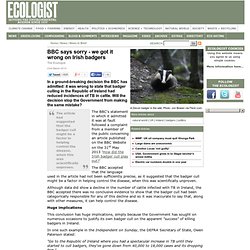
The BBC's statement in which it admitted it was at fault followed a complaint from a member of the public concerning an article published on the BBC Website on the 31st May 2013 'How did the Irish badger cull play out? ' The BBC accepted that the language used in the article had not been sufficiently precise, as it suggested that the badger cull might be a factor in helping control the disease, when this was scientifically unproven. Although data did show a decline in the number of cattle infected with TB in Ireland, the BBC accepted there was no conclusive evidence to show that the badger cull had been categorically responsible for any of this decline and so it was inaccurate to say that, along with other measures, it can help control the disease. Huge implications. Badger cull claims flawed, vets say. Government claims that badger culling is needed to tackle tuberculosis in cattle based on successes in other countries are "seriously flawed", a group of vets has said.
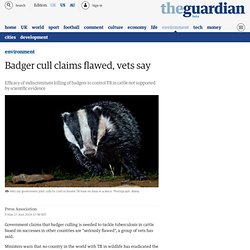
Ministers warn that no country in the world with TB in wildlife has eradicated the disease in cattle without controlling it in wild species, pointing to programmes in places such as New Zealand, Ireland and the US. But in a letter to the Veterinary Record, 19 vets raised concerns about the claims, saying that very few countries had needed to kill wildlife as part of TB control programmes. In New Zealand brush tail possums have been targeted to tackle TB, but the species is not a native breed, has caused significant problems for other wildlife and has very different habits and social structure to badgers, the vets said.
Diesel exhaust rapidly degrades floral odours used by honeybees : Scientific Reports. Chemical odours are central to communication in insects and their interaction with the environment1.
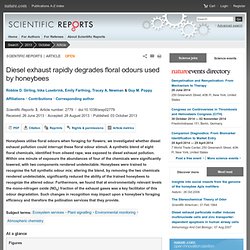
A prime example of this is the floral odours that are produced by flowering plants to manipulate the behaviour of insects and facilitate pollination2, 3. Globally the economic value of pollination has been estimated at [euro]153 billion a year4, with 70% of the world's principal food crops relying upon pollination, equating to 35% of global food production5. Pollinator populations are declining on a global scale6 and anthropogenic substances, such as synthetic insecticides, are implicated as key contributors to the reductions of both wild7, 8 and managed pollinators9, 10, 11.
Honeybees (Apis mellifera) are our most significant managed pollinator, yet every year significant numbers of honeybee colonies unexpectedly die worldwide6, 9. Air pollution is one of the most ubiquitous environmental human impacts13, however its effects on honeybees are unknown. Palm oil's forgotten victims: Sumatran elephants suffer in rush for 'liquid ivory' Everyday we read about the tragic death of another African elephant slaughter, the world watching in horror at the sight of desiccated carcasses, dried pools of blood and crudely-hewn stumps where tusks once were;snapshots from distant crime scenes feeding a ghoulish market for ivory in the Far East.
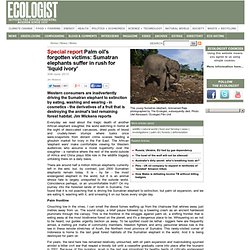
Le renard n'est-il «nuisible» que pour les chasseurs ? De Mme Nadège Engel le 8 juillet 2012, ces précisions à la lecture de l’article «Attention aux renards près des habitations» diffusé sur le site vosgesmatin.fr. « Je me permets de vous contacter pour vous donner des informations sur le statut de nuisible du renard, lequel permet tous les excès les plus cruels envers cet animal qui est un “canidé” et qui subit toutes les tortures qu’un homme peut faire subir à un animal quand aucune loi ne l’arrête: pièges à mâchoire, poisons, lacets, etc. dans lesquels nos chiens et nos chats sont également attrapés et empoisonnés en se promenant, (joint un article basé sur la science, ce message est envoyé à chaque DREAL et à chaque préfet de Région qui décide du statut des animaux “nuisibles”, “utiles” ou “protégés”, comme s’il pouvait y avoir des vies nuisibles).
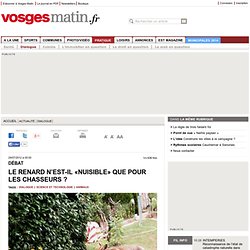
Le renard représente-t-il une menace pour la santé publique? Le risque de contamination pour l’homme est présent en cas de consommation de végétaux souillés par des déjections infectées […]. Quand tuer le renard devient une « fête »